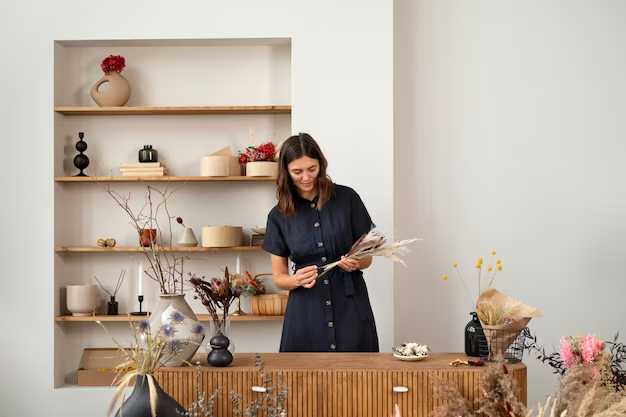How to Build an eCommerce Store for Home Decor from Scratch!

The home decor sector is growing, with revenue projected to reach $40.55 billion by 2024. Some of the forecasts even show an amazing yearly growth rate of 8.51% from 2024 to 2029, possibly reaching US$60.99 billion.
This increase shows no sign of slowing down!
Therefore, the home decor industry is one of the best areas for someone who wishes to start an online business. While the opportunities in this market are favorable, a new business owner must be well-prepared to deal with the difficulties coming with it.
Finding the right materials, supervising the market, and using proper advertising norms are the success keys for good eCommerce stores.
In this article, we’ll cover all you need to know to launch a profitable home decor eCommerce business. Whether you’re an experienced entrepreneur or just getting started, this step-by-step guide will provide the knowledge and approaches you need to make your idea a reality.
So, let’s get started!
How to Build an Online Home Decor Store — A Step-by-Step Guide
Starting your own online Home Decor store is an exciting journey, and breaking it down into manageable stages will help you handle the process smoothly.
From the initial brainstorming to starting your store, each step is crucial for setting a solid base for your business. In this section, I’ll walk you through each stage of building a successful online home decor store.
Step #1 — Make Your Mind On Business Niche

The Home Decor market is full of options; however, to stand out, choose a niche that matches your interests and focuses on areas where consumers are willing to invest the most.
Here are some categories in Home Décor that can help you choose your specialized niche:
| Sub-Categories Under Home Decor Niche | |
| Furniture | Sofas, armchairs, beds, tables, chairs, dressers, bookshelves, ottomans |
| Rugs & Carpets | Add color, pattern, texture, warmth, and comfort |
| Lightening | Lamps, chandeliers, sconces, pendants (set the mood & provide task lighting) |
| Wall Decor | Artwork, mirrors, clocks, tapestries, sculptures (add personality & visual interest) |
| Textiles | Throw pillows, throws, blankets, table linens (add color, pattern, texture & coziness) |
| Tabletop Decor | Vases, bowls, candles, decorative objects (personal touch to tables & shelves) |
| Greenery & Plants | Houseplants (add life, color, purify air) |
| Seasonal Decor | Holiday decorations, outdoor furniture (specific to seasons) |
These are only a few examples; the decor industry has many more sub-niches to explore. The key is to choose one that you are passionate about. Consider your interests and select a sub-niche that excites you and connects with your objectives.
After choosing your niche, create a solid business plan to guide your success. Let’s look at how to build an effective eCommerce business plan for your Home Decor store.
Step #2 — Work On Your Business Plan

With your niche chosen, the next crucial step is building a thorough business plan. This plan will guide you on how you’ll bring in product supplies, manage inventory, profit margins, and all the necessary areas that set the stage for success.
One key part of your business plan is picking a business model. Here are the several business models that you should when working in the home decor industry.
1. Manufacturing
Under a manufacturing approach, you design your home decor products. This strategy allows you to control your products’ design and quality.
2. Handcrafted Goods
This approach involves creating one-of-a-kind handcrafted home decor pieces. It’s perfect for those with creative ability or who love handcrafted goods.
3. Dropshipping
Dropshipping is a business model where you sell home decor products without holding any inventory.
When a customer places an order, you purchase the product from a third-party supplier, who then ships it directly to the customer. This model reduces overhead costs but relies heavily on suppliers for fulfillment and quality control.
4. Curating & Selling from Online Marketplaces
This model is about sourcing unique or trending items from various online marketplaces and reselling them on your platform. It’s a great way to offer a diverse range of products without making them yourself.
5. Upcycled & Refurbished Decor
This model aims to breathe fresh life into old or vintage home decor items by upcycling and refurbishing. It’s an excellent alternative for those who care about their environmental impact and seek sustainability.
Now that we’ve covered the different business models, let’s learn their pros and cons. Each model has its own strengths and challenges, and understanding them can help you make more informed decisions for your business.
| Business Model | Benefits | Potential Drawbacks |
| Manufacturing | — Full control of product quality — Full control of product quality and design — Higher profit margins — Create unique, products — Easier inventory control | — High upfront investment — Requires specialized skills or staff — More complex logistics and inventory management — Longer product development times |
| Handcrafted Artisanal Goods | — Charge premium for unique items — Attract authenticity seekers — Lower startup costs — Quick design adaptability | — Limited scalability — Time-consuming — Quality consistency challenges — Tough to compete on price |
| Dropshipping | — Very low startup costs — No inventory or storage management needed — Easy to test products with no upfront investment — Operate from anywhere with internet access | — Lower profit margins due to supplier fees — Less control over product quality and shipping — High competition with low entry barriers — Risk of stockouts from supplier inventory issues |
| Curating & Selling from Online Marketplaces | — Low initial investment — Wide variety of products — Flexibility to update inventory with trends — Opportunity to build a unique brand | — Time-consuming product sourcing and listing — Inconsistent quality from suppliers — Risk of product discontinuation — Constant need to refresh inventory |
| Upcycled & Refurbished Decor | — Appeals to eco-conscious consumers — High-profit margins on transformed items — Unique, one-of-a-kind products — Lower material costs if sourced cheaply | — Labor-intensive and hard-to-scale — Inconsistent inventory from sourcing items — May need specialized skills or tools — Pricing challenges due to varying input costs |
Every model has certain benefits and drawbacks. It’s important to invest the time to get it properly, as your choice of business model will affect everything from your daily operations to your marketing plan.
Once you have chosen a plan of action, you will be ready to proceed to the next crucial step: giving your business a unique name. Let’s proceed to learn how to do this.
Step #3 — Choose a Business Name & Register a Trademark

Once you’ve sorted your business plan, it’s time to focus on branding elements.
Start by choosing a business name, registering a trademark, and securing a domain name. These steps are key to building your brand and establishing your online presence.
Let’s do it.
1. Choose a Store Name
The first thing you do is choose a name for your home decor store. And it’s necessary for you to choose a name very carefully as it has an impact on multiple areas that can make or break your business.
Here are some tips for you can utilize, when you get ahead to choose a store name.
- Keep it easy to pronounce.
- It should express the brand’s personality.
- Make sure it’s available for trademark registration, under the domain name, and on social media.
2. Register Trademark
Brand registration is one way to protect your brand from piracy, and it is very important.
Here’s how and why you should do it:
First, make sure the name you want is available by checking your state’s business registry. Once you see it available, quickly proceed to it as a trademark. This will provide you with legal protection for your brand name, logo, slogan, or any other elements, preventing others from using it without your consent.
Next, don’t forget to check if the name is available as a domain for your website.
3. Purchase Domain Name
The domain name is the address of your business on the internet, thus being the primary identification customers will use to be able to locate and enter your website.
Pick a domain that matches your company name and brand. Choosing a top domain name provider like GoDaddy, Namecheap, and Bluehost guarantees successful registration.
Also, the domain extension matters equally for your business success. For your home decor store, you might choose .com, net, or .store. Most people prefer using the .com extension as it’s highly familiar among shoppers.
For more information: choose an eCommerce domain name
Now, that your business name, trademark, and domain are all set, it’s time to pick the right eCommerce platform for your store. Let’s explore how to choose the best one for your business!
Step #4 — Choose an eCommerce Platform

With your company name, trademark, and domain in place, the next step is to select the most suitable eCommerce platform. The eCommerce platform you choose will impact multiple areas of development, management, and maintenance. The key is to choose it wisely.
Each eCommerce platform offers different features to accommodate various business needs, sizes, and budgets. To help you make an informed decision, I’ve compiled a table of top eCommerce platforms.
Check out the following table to find the best eCommerce platform for your online home decor business.
| Aspect | Shopify | Magento | WooCommerce (WordPress) | BigCommerce | Squarespace | Wix |
| Pricing (monthly) | Starts at $29 | Free (with paid third-party hosting) | Free (with paid WordPress hosting) | Starts at $80 | Starts at $26 | Starts at $18 |
| Ease of Use | Very Easy | Little Difficult | Moderate (requires WordPress knowledge) | Easy | Easy | Very Easy |
| Target Audience | Beginners, Small & Medium Businesses | Small to Large Businesses | Small & Medium Businesses | Medium Businesses | Small & Medium Businesses | Beginners, Small & Medium Businesses |
| Built-in Marketing Tools | Yes | Yes | Requires Plugins | Yes | Yes | Yes |
| Scalability | Highly Scalable | Highly Scalable | Scalable with Plugins | Highly Scalable | Moderately Scalable | Moderately Scalable |
| App Marketplace | Large App Store | Large App Store | Large Plugin Marketplace | Large App Store | Moderate App Store | Moderate App Store |
| Design Flexibility | Good | Excellent | High (with coding knowledge) | Good | Good | Good |
Having all the information is a great start, but selecting the right platform can still be challenging. To assist you further, check out these additional tips below to guide you in making the best choice.
- Shopify: Ideal for newbies and small to medium businesses with marketing automation and eCommerce features built in.
- Magento: Magento is best for bigger businesses with their own IT staff who prefer extensive customization and growth with high scalability.
- WooCommerce: A flexible option that allows you to add various plugins while you have experience with WordPress.
- BigCommerce: Top choice for medium businesses looking for a multichannel selling, feature-rich eCommerce platform with cloud hosting and strategy consultancy.
- Squarespace: It is recommended for small companies if they only need an easily scalable and design-centric approach.
- Wix: A cloud-based, most user-friendly platform for beginners, affordable, and fastest.
For a further comprehensive analysis, read: Choosing the Best eCommerce Platform.
After selecting your platform, it’s time to focus on branding. This step will shape your Home Decor store’s visual identity and ensure it stands out. Let’s explore the key elements of effective branding.
Step #5 — Get Your Branding Done

At this stage, you’ll focus on creating a brand that resonates with your customers and distinguishes your store. Strong branding is essential for making your Home Decor online shop both memorable and appealing. Let’s take a closer look at the key aspects of effective branding.
1. Create a Logo
Your logo is essentially the face of your brand, making it one of the most critical elements of your business identity. You need a unique logo if you want to communicate the essence of your brand to your audience. Here we have some tips for you to create a logo that truly represents your brand:
- Ensure your logo is easy to recognize and looks good in every size.
- Make sure it reflects your store’s style and values.
- Test how it looks on your website, social media, and marketing materials.
By focusing on simplicity, consistency, and versatility, you can create a logo that looks impressive and effectively represents your brand across all touchpoints.
2. Create a Strong About Us Page
Your About Us page offers an opportunity to interact with your clients personally. This is how to create interesting content:
- Tell your story to customers and share your brand’s origin, goals, and what sets you apart.
- Connect with your audience, address your target customers directly, and highlight how your brand meets their needs.
- Use a genuine and engaging style that reflects your brand’s personality.
- Focus on benefits such as how your products improve the customer’s experience and lifestyle.
- Lastly, proofread & edit to ensure your content is error-free and professionally presented.
With your logo and About Us page set, the next step is to define what makes an ideal home decor eCommerce store. This will help you create a website that provides an exceptional shopping experience. Let’s explore how to set and meet these expectations!
Step #6 — Figure Out Your Expectations For an Ideal Home Decor Website

With your branding strategy in place, it’s time to outline your ideal “Home Decor” website. So, start by figuring out website features, design preferences, and budget to ensure everything aligns with your vision.
Let’s learn everything piece by piece.
1. List Desired Features
Start by listing the essential features you want for your Home Decor website. Here are some top features to consider:
- Product Display
- Product Customization Options
- Search Functionality
- Filters and Sorting
- Customer Reviews
- User Accounts
- Wishlist
- Social Media Integration
- Live Chat Option
- Blog and Content Section
These features are just a starting point. Feel free to explore and choose the ones that best fit your business needs.
2. Design Style and Aesthetics
Next, consider the design aesthetics and style that might work best for your Home Decor brand. Here, we have got some tips for you:
- Match your design with your brand’s style—modern, traditional, or somewhere in between.
- Choose colors that enhance readability.
- Use fonts that align with your brand’s look and ensure they are easy to read.
- Add high-quality visuals that showcase your products and appeal to your audience.
With these design elements in mind, you’ll be well on your way to building a visually appealing and cohesive website.
3. Must-Have Pages and Elements
With the design elements sorted, it’s time to outline the core pages for your website. Let’s identify the essential web pages that are highly necessary for you to include in your home decor store.
- Home Page
- Product Category Pages
- Individual Product Pages (IPPs)
- About Us Page
- Contact Page
- FAQ Page
- Shipping and Returns Page
- Privacy Policy and Terms of Service
- Cart and Checkout Pages
For more detailed information about the important web pages for your eCommerce website, check out our eCommerce website page list.
Defining your website’s functions and design style is necessary as you need to explain it to web developers and designers in the next step. Doing this helps them build the website of their dreams while avoiding revisions and quicker time to market.
Now, it’s time to move on to designing and developing your home decor website.
Step #7 — It’s Time to Design & Develop Your Home Decor Website

Designing and developing your online store will require you to hire the right team of experts. Here’s how to find talented designers and developers:
Where to Find Design & Development Professionals:
- Freelance Platforms: Websites like Upwork and Fiverr offer a range of freelancers with various skills and price points.
- Google Search: A quick search can reveal local and remote design and development options.
- Recommendations: Ask for referrals from friends, family, or other businesses in the home décor industry.
When choosing a designer or developer, consider their portfolio, experience with home décor and eCommerce sites, communication skills, and pricing.
For a reliable option, consider Aureate Labs. Our team of eCommerce experts specializes in creating stunning and functional home décor websites and can guide you through the entire process.
Once you’ve selected your team, share all the details from your planning phase to ensure they understand your needs. This will help them provide accurate budgets and timelines and deliver a website that truly shines.
And that calls for a time to move on to the next section.
Step #8 — Start Listing Your Products

With your home decor website fully developed, the next crucial step is product listing. How you present your products can significantly impact customer experience and future sales. Here’s a process on how you do it the best way.
Start by compiling a list of your products and their details in a spreadsheet or document to streamline the upload process. As you list each item, focus on the following:
- Product Name: Ensure it’s clear and descriptive.
- Description: Write engaging, informative descriptions highlighting unique features and benefits.
- Imagery: Use high-quality images from multiple angles and in real-life settings.
- Categories: Organize products into relevant categories.
- Details: Include any unique attributes, such as variations or special features.
These elements will help customers find and understand your products better, influencing their purchasing decisions and enhancing their shopping experience.
With your product listings complete, it’s time to attract customers by optimizing your website for search engines. This ensures your home decor shop reaches a wider audience and ranks higher in search results. Let’s explore key techniques to boost your website’s search visibility.
Step #9 — Start Optimizing Your Website for Search Engines

After setting up your home décor store, ensure people can find their way to it. So, launching your store with pre-launch SEO is one of the most secure strategies to ensure stable visitors for your site in the long run.
Here are some SEO optimization tips for you to work on:
- Keyword Research
- High-Quality Content:
- On-Site SEO
- Website Structure
More SEO Essentials:
- Internal Linking
- Page Speed
- Mobile Optimization
- Schema Markup
With these SEO strategies, your Home Decor store will draw more organic traffic and you’ll rank higher in search results.
Next up is creating important pages for your online store to build trust among customers.
Let’s build these pages and connect with your ideal customers!
Step #10 — Create Policy Pages

Policy pages are essential for every eCommerce store to build customer trust and protect your business. These pages set the ground rules and ensure smooth transactions. Here’s what you need to include:
- Return Policy
- Shipping Policy
- Refund Policy
- Privacy Policy
- Terms & Conditions
- FAQ Page
Start drafting these policies, making sure each one is clear and concise. Include all necessary details specific to your store to make it easy for customers to understand and follow.
With your policies in place, move on to the next step. This step ties up loose ends and prepares your Home Decor store for a successful launch. Let’s finish strong and get your store ready for business!
Step #11 — Work on Remaining Tasks
With the core elements of your online store set up, it’s time to focus on the final touches to ensure everything runs smoothly. Here’s your checklist:
1. Choose a Payment Processor
For a seamless and secure shopping experience, select a reliable payment processor. Research options that offer robust encryption and adhere to industry standards like PCI DSS. Popular choices include:
- Credit/Debit Cards (Visa, Mastercard, American Express)
- PayPal
- Stripe
- Apple Pay
- Google Pay
- Bank Transfers
Ensure your chosen processor integrates well with your eCommerce platform and protects sensitive customer information.
2. Protect Your Store & Customers

Security is essential for maintaining trust and safeguarding your business.
Here are the essential measures you should implement:
- SSL Certificates: SSL certificates secure the information that is shared between your website and its visitors and, in doing so keep items like credit card numbers safe.
- Fraud Prevention Tools: Credit card payments could be monitored using advanced fraud detection technology that will detect some suspicious transactions and customer behavior that may result in fraud prevention as a result of smart criminal activities.
- Data Backups: Through regular backups, your website is protected against data loss from hackers or hardware failures. These backups ensure that your websites recover quickly, and you lose no business or time.
By following these security protocols, you have a safe online shopping site, which in turn promotes trust among your customers as well as protects your business from possible threats.
3. Make a Test Order
Before going live, conduct a test order to ensure everything works perfectly. Here’s how:
- Navigate your site as a customer, adding items to the cart and completing checkout.
- Verify that product descriptions, images, and promotions are displayed correctly.
- Test the checkout process, including both guest and registered user options.
- Check payment processing and ensure all payment methods work.
- Review confirmation pages and automated emails.
- Track shipping and test the return or refund process.
Address any issues that arise during testing to provide a smooth shopping experience for your customers.
With these tasks completed, your Home Decor store is set to launch. Now, prepare for the big reveal and get ready to attract and engage your customers!
Step #12 — Get the Word Out
Your Home Decor store is nearly ready, and it’s time to plan your grand opening. Here’s how to ensure a successful launch and attract attention:
1. Set a Launch Date
Choose a launch date that fits well with your marketing plan and resonates with your target audience.
Consider festive timings, such as seasonal peaks or relevant events, that could boost customer engagement. This will be your target for finalizing preparations and kicking off your promotional activities.
2. Master Marketing & Set Up Social Media
Mastering marketing and setting up your social media presence are key to engaging your audience.
Start by writing down your online objectives & learning key marketing tactics, including SEO, content marketing, email campaigns and social media to keep customers coming back.
Second, create business profiles on platforms like Instagram, WhatsApp, Facebook, Pinterest, Twitter, etc, that showcase your designs in ways that appeal to your target market. Besides, working with influencers gives you exposure for your online store by taking advantage of their follower base.
3. Promote Your Launch on Social Media
Promote your launch with social media promotions to generate excitement about your launch. Here are some content ideas you can work on:
- Engaging content like teasers or countdown posts can create anticipation in your followers.
- Design promotional materials for your website and social media.
- Launch deals like discounts, bundle offers or free shipping will draw customers in
- Work on early-bird promotions or special offers to get your first customers.
Step #13 — Go Ahead & Launch It! 🚀
The big moment is here! Your Home Decor store is ready to make live for customers..
Celebrate your hard work. Your vision is now real!
But don’t stop here. To maintain the excitement and keep your store succeeding, we have some more tips for you. Let’s now dive into the best practices for running a successful home decor eCommerce business.
Best Practices for Building a Successful Home Decor eCommerce Store
Creating a top-notch Home Decor store isn’t just about listing products. It’s about delivering an exceptional shopping experience. Here’s how to make your store stand out.
1. Integrate 360° View or AR Functionalities
360° view technology allows customers to rotate and zoom in on products like large furniture from every angle so that they can inspect it the way they would in a store.
AR goes a step further as it lets customers visualize what an item will look like in their space. For instance, they can virtually place a sofa in their living room to check if it fits.
These interactive features improve the shopping experience, reduce decision times and return costs, and ultimately build trust. They give your customers the trust to make a purchase and make your store more appealing and innovative.
2. Stay Ahead of eCommerce Trends.
Trends like personalization, voice commerce, sustainability, and social commerce are changing the industry, and businesses that adopt them are in a better position for growth.
Stay ahead with eCommerce trends to provide a better user experience.
Moreover, offering eco-friendly products or making purchasing easier with voice commands can also do great help. When you adapt to emerging user expectations, you get to improve your store and differentiate it from competitors.
Want more insights on eCommerce trends?
Explore our article on latest eCommerce trends to gain a deeper understanding.
3. Product Customization Options
Product customization in home decor makes your business stand out and keeps customers satisfied.
They appreciate when they are allowed to customize their product. Be it about choosing the color, fabric, or size of your furniture item, they’ll appreciate it.
To make the customization process intuitive and engaging, ensure it’s user-friendly.
4. UGC Section
To establish credibility and connect with your audience, including user-generated content on your website is a good idea.
Customer reviews, pictures, and recommendations can be powerful social proofs and a valuable source of feedback about your products. In this way, potential buyers can feel more confident about their purchasing decisions.
You might consider integrating custom areas in your product pages that consist of customer feedback and photo albums. Ask customers to share their photos and experiences with you, on the product page if they will, or on a dedicated UGC page.
As a result, the credibility of your website will be increased, and your brand will establish itself as a community of people.
5. Provide a Greater Shopping Experience
Making unforgettable shopping means thinking more than just building the website.
What matters more is adding value and ensuring your customers have a smooth journey. If you don’t know what exactly helps to give a better user experience, here are some tips you may follow.
- Provide resources such as styling guides, product care tips, or DIY ideas to help them decide on purchasing.
- Use quality images, videos, and detailed descriptions for your home decor items.
- Keep your website layout simple with easy navigation elements.
The focus of online shopping should be on these important features that outweigh the consumer’s expectations, hence, investing in these features is worth it as it leads to loyalty.
;
Would you like to know how the top Home Decor brands are succeeding?
The next part will discuss five online Home Decor brands famous for their creativity and top-notch services. Let us explore their formula for success.
5 Best Online Home Decor Brands to Take Inspiration From
In this section, I’ve listed 5 brands in the home decor industry that provide the best user experience through their online store, which helps bring in most of their revenue.
1. Best Online Cabinets
Best Online Cabinets has a very professional appearance with the well-detailed content on the website. The main features included are:
- Wide selection of kitchen and bathroom cabinets, including stock, semi-custom, and custom options.
- Offers various cabinet styles like traditional, shaker, and contemporary, catering to diverse aesthetics.
- Customization options available for door styles, finishes, and hardware.
- User-friendly site with clear categories, advanced filters, and detailed product information.
- Free design services, offering 3D renderings to help customers visualize their space.
- Financing options, free shipping, and a price match guarantee for added value.
- Mobile-optimized website for easy browsing on the go.
Know More: Best Online Cabinets
2. Rejuvenation
The sleek design and premium products are what make Rejuvenation so special. The key highlights are:
- Wide range of lighting, furniture, and accessories.
- Offers “Product Configuration Options”, especially for lighting.
- Sustainable and Fair Trade Certified materials.
- Intuitive layout with clear categories.
- Detailed product info and high-quality images.
- Free design consultations and trade discounts.
- Customer reviews are available.
- Regular promotions and clear shipping policies.
- Mobile-optimized for smooth browsing.
3. Crate & Barrel
Crate & Barrel delivers an engaging shopping experience through the use of very illustrative videos and product images. The key features of the website are:
- Wide product selection, including furniture, decor, and kitchen essentials.
- Customizable sofas and sectionals with various fabric options.
- Easy-to-navigate layout with endless scrolling for effortless browsing.
- Comprehensive product details with high-quality images for better visualization.
- Free interior design services are available in-store, at home, or virtually.
- Interactive tools like the sectional configurator for personalized designs.
- Special financing options and a rewards program for member perks.
- Free shipping on select items, with mobile app support for one-click payments and registry management.
4. Urban Outfitters
Catering to a young audience, Urban Outfitters offers colorful, innovative designs and attractive features. The main components are:
- Wide selection of home decor items, including furniture, bedding, and accessories, with trendy designs.
- Easy-to-navigate site with clear categories to find products quickly.
- Detailed product pages with comprehensive descriptions, dimensions, and high-quality images.
- Frequent sales, including seasonal promotions, and free shipping on qualifying orders.
- UO Rewards Program offers points and discounts, alongside a mobile app for app-only deals.
- Social media integration, featuring user-generated content and decor inspiration.
- Lifestyle photography and style guides for visual inspiration and decor tips.
5. Minted
Minted provides a one-of-a-kind experience with products and designs that are personally curated by artists. The key features of the website are:
- Minted offers home decor products with original designs from independent artists worldwide.
- Products are ethically sourced, with a commitment to sustainability and fair labor.
- Offer Welcome Discount 20% discount to new customers.
- Detail product description, shipping, and returns details on the product page
- Easy categorization of products.
These brands are great examples of how to succeed in online selling. They have attractive designs, clear product details, and easy checkout processes. You can learn a lot from their strategies to improve your own store.
Conclusion
Starting an online home decor store is an exciting adventure with lots of opportunities to explore.
By choosing the right eCommerce platform and focusing on a niche that you’re excited about, you build a strong basis for your business. It’s important to build a well-designed website and make comprehensive lists of products to represent the quality of your store.
Moreover, learning from great brands can provide useful insights and help you improve strategies and meet your customers’ demands effectively.
Quality and creativity are key to finding success in the online home decor business. As you start your store, stay confident, be creative, and let your passion guide you.
If you have any questions or need further guidance, our team of eCommerce experts is here to help. We offer free consultations to address any doubts you might have. Feel free to book a meeting with us to get personalized advice.
We look forward to supporting your journey. Thank you!






Post a Comment
Got a question? Have a feedback? Please feel free to leave your ideas, opinions, and questions in the comments section of our post! ❤️